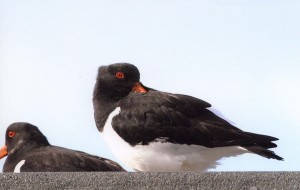 The large family of birds called “waders” are some of the most difficult to identify especially when they are in their winter plumage. One of the exceptions is the oystercatcher that at all times of the year is easy to identify. The combination of black and white plumage contrasting with the long orange red beak is unmistakable. It is also a very common and widespread wader both during the breeding season and during the winter months. During the winter months they often gather in flocks numbering hundreds and even, occasionally, more. They are a feature of sites such as Nigg and Udale Bays on the east coast. At both these sites they are readily observed from the excellent RSPB hides that are open to the public at all times of the year. Whilst some of these birds may well be the ones that have bred inland, a large number of these move south for the winter. Their place is taken by huge numbers that migrate in from Scandinavia and Iceland.
The large family of birds called “waders” are some of the most difficult to identify especially when they are in their winter plumage. One of the exceptions is the oystercatcher that at all times of the year is easy to identify. The combination of black and white plumage contrasting with the long orange red beak is unmistakable. It is also a very common and widespread wader both during the breeding season and during the winter months. During the winter months they often gather in flocks numbering hundreds and even, occasionally, more. They are a feature of sites such as Nigg and Udale Bays on the east coast. At both these sites they are readily observed from the excellent RSPB hides that are open to the public at all times of the year. Whilst some of these birds may well be the ones that have bred inland, a large number of these move south for the winter. Their place is taken by huge numbers that migrate in from Scandinavia and Iceland.
Whilst the birds may be more or less confined to the coast in the winter months, during the summer they are widespread inland and they sometimes breed in the most unlikely places. A good example is the flat roofs of the Inverness Academy school. They can nest there because, unlike the young of other waders, the chicks rely on food brought in by the parents. Successful nests have been known in a flower bed just outside the terminal at Inverness airport and on the edge of the car park at the Dingwall Mart. They can also be found only inches from the tarmac on some country roads near rivers where the strip of shingle must remind them of the upper parts of a beach on the coast. I took the photograph of a bird with beak tucked under its wing feathers as it sat on top of a bus shelter near Croy. Whilst some stay on the coast and breed others will move far inland and will nest on open fields sometimes along with lapwings and curlews. The chicks are well camouflaged as a narrow pale line of feathers behind the head makes the head and body look like two small pebbles. In that way they can outwit the ever present hooded and carrion crows.
Ringing birds has given us a greater awareness of what oystercatchers do at various times of the year. Many of the oystercatchers are caught at this time of the year and in the winter when they gather in their large flocks in the firths. The Highland Ringing Group rings around 200 to 300 a year and this is where much of the information on them in the Highlands has been obtained. Such was the case with one that was brought to me in March 2004 having been found near Farr just south of Inverness. The bird had hatched in 1976 and was first ringed near Inverness in 1978. It was re-ringed, because the original ring was worn, at Alterlie Point east of Inverness in 1991. When the bird was given to me it was still alive but I had to put it down as it had two shattered legs. At its death the bird had lived for 28 years which is old for a wild bird although not unknown as the longest oystercatcher known was 31 years old. It is interesting that this flamboyant bird has not captured the imagination of the Highland poets such as Norman MacCaig. Scots names include Sea Pilot and Shelder whilst the commonest Gaelic name is Gille-Brighde meaning Servant of St. Bridget.
